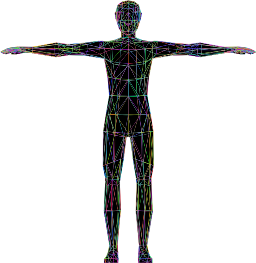The human body is a complex biological system involving cells, tissues,
organs, and systems all working together to make up a human being.

Human Body
Main Structures
From the outside, the human body can be divided into several main structures. The head houses the brain which controls the body. The neck and trunk house many of the important systems that keep the body alive and healthy. The limbs (arms and legs) help the body to move about and function in the world.
Senses
The human body has five main senses that it uses to convey information about the outside world to the brain. These senses include sight (eyes), hearing (ears), smell (nose), taste (tongue), and touch (skin).
Organ Systems
The human body consists of several organ systems. Each system is made up of organs and other body structures that work together to perform a specific function. Most scientists divide the body into 11 systems.
From the outside, the human body can be divided into several main structures. The head houses the brain which controls the body. The neck and trunk house many of the important systems that keep the body alive and healthy. The limbs (arms and legs) help the body to move about and function in the world.
Senses
The human body has five main senses that it uses to convey information about the outside world to the brain. These senses include sight (eyes), hearing (ears), smell (nose), taste (tongue), and touch (skin).
Organ Systems
The human body consists of several organ systems. Each system is made up of organs and other body structures that work together to perform a specific function. Most scientists divide the body into 11 systems.
- Skeletal System - The skeletal system is made up of bones, ligaments, and tendons. It supports the overall structure of the body and protects the organs.
- Muscular System - The muscular system works closely with the skeletal system. Muscles help the body to move and interact with the world.
- Cardiovascular/Circulatory System - The circulatory system helps deliver nutrients throughout the body. It consists of the heart, blood, and blood vessels.
- Digestive System - The digestive system helps to convert food into nutrients and energy for the body. Some of the organs included in the digestive system are the stomach, small intestine, large intestine, liver, and pancreas.
- Nervous System - The nervous system helps the body to communicate and allows the brain to control various functions of the body. It includes the brain, spinal cord, and a large network of nerves.
- Respiratory System - The respiratory system brings oxygen into the body through the lungs and windpipe. It also removes carbon dioxide from the body.
- Endocrine System - The endocrine system produces hormones that help regulate the other systems in the body. It includes the pancreas, adrenal glands, thyroid, pituitary, and more.
- Urinary System - The urinary system uses the kidneys to filter the blood and eliminate waste. It includes the kidneys, bladder, and urethra.
- Immune/Lymphatic System - The lymphatic and immune systems work together to protect the body from diseases.
- Reproductive System - The reproductive system includes the sex organs that enable people to have babies. This system is different for males and females.
- Integumentary System - The integumentary system helps protect the body from the outside world. It includes the skin, hair, and nails.
Cells, Tissues, and Organs
Like all living organisms, the human body is made up of cells. There are all different types of cells in the human body. When lots of similar cells work together to perform a function, they make up tissue. There are four main types of tissue in the human body including muscle tissue, connective tissue, epithelial tissue, and nervous tissue.
Like all living organisms, the human body is made up of cells. There are all different types of cells in the human body. When lots of similar cells work together to perform a function, they make up tissue. There are four main types of tissue in the human body including muscle tissue, connective tissue, epithelial tissue, and nervous tissue.
Organs are somewhat independent parts of the body that carry out special
functions. They are made up of tissues. Examples of organs include the
eyes, heart, lungs, liver, and stomach.
Interesting Facts about the Human Body
Interesting Facts about the Human Body
- The human body is made up of around 37 trillion cells.
- The average human heart beats around 100,000 times every day.
- If you spread out the wrinkles in the brain it would be about the size of a pillow case.
- Fingernails grow much faster than toenails. They are both made of a protein called keratin.
- About 60% of the human body is made up of water.
- The brain itself does not feel pain.
- The largest of the human internal organs is the small intestine.
- Acid in the stomach is powerful enough to dissolve some metals.
- The left lung is typically around 10% smaller than the right lung. This is to make room for the heart.
- Humans are born with 270 bones. Several of these bones fuse together by adulthood making a total of 206 bones in the adult human body.
No comments:
Post a Comment